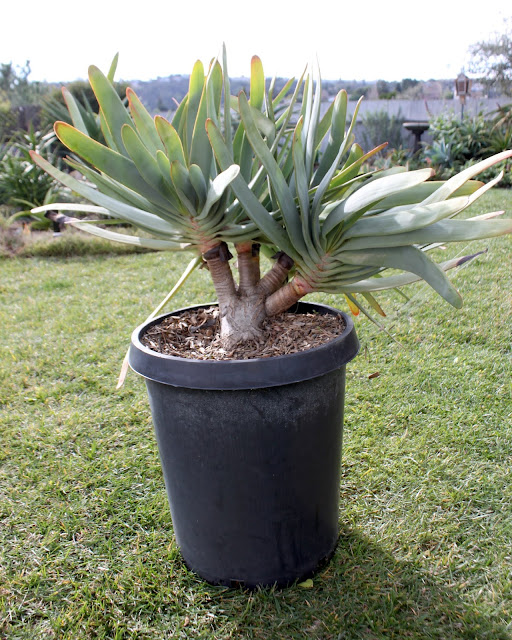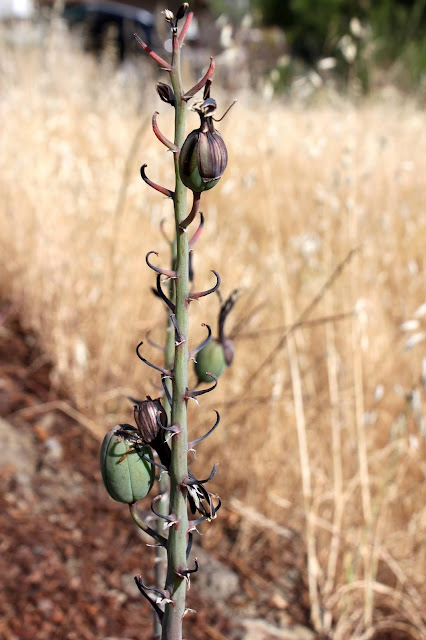Planting an Aloe plicatilis
We've also had some sunny days recently which always prompts me to get outside and do something productive! The Aloe plicatilis pictured below has been living in this pot for the better part of 3 years - time for it to find a better home.
 |
| A handsome Aloe plicatilis ready for a new home |
I'm not entirely sure why I'd never planted it before - probably because I couldn't find a spot for it initially. As I've thought more about expanding the hillside garden wall, new planting real estate and opportunities came to mind.
 |
| Yes, this is a picture of a hole. |
Dirt. It's an inevitable part of planting. This hole is wider than needed but I wanted to make sure I had space to position the plant as needed. I've left a layer of loose, native soil at the bottom.
Once I get this Aloe in the hole I'll need to back fill around the plant - so in the shots above you can see my mix of native soil, new soil and 5/8 inch crushed volcanic rock. Hopefully good enough.
 |
| Testing for correct depth |
Because this is a larger specimen living in a big pot with lots of heavy, wet dirt I want to make sure I've dug the hole to the correct depth before trying to remove the plant.
Before removing it from the pot I usually step back and view the plant from a few angles to make sure it's being presented as best as possible.
 | |
| Same hillside one month earlier in late November |
Just a quick detour back in time to demonstrate what this space looks like at the end of our usual 6+ month dry season. Digging a hole in this dirt takes a long time - and in fact I usually end up breaking out the 12lb digging bar.
 |
| Root ball after removing old or dead roots |
I wasn't sure what to expect after leaving this plant for so long in a 15 gal pot. The rootball had definitely grown to fill the entire container but didn't look root-bound just yet. I removed quite a lot of root material and dirt trying to find an ant colony I suspect took up residence. I found lots of ants - or rather they found me! Because of the weight / size of this specimen, I asked my daughter to help hold the pot while I tipped it upside down and used gravity to gently remove the goods.
 |
| Uh, oh. Not a good sign |
The ants have been farming aphids on my poor Aloe for at least a 18 months now :( I periodically spray them with isopropyl alcohol and even wipe between the leaf joints to physically remove the aphids.
 |
| Many joints of this Fan Aloe reveal aphids |
Super annoying!
 |
| Removed leaves showing pest damage |
Eventually the aphids do enough damage that the leaves die prematurely. Clearly I have not been vigilant enough.
 |
| Close up of damage caused by aphids |
 |
| Planted! |
But amazingly this specimen still looks happy. I also put down a layer of gravel to help ameliorate muddy splash back from the rain storms I'm sure will arrive over the next 3 months. Eventually I'll place more Telluride dry-stack behind this aloe to help retain the hill. For now I'm happy to let this Aloe get established - later we'll fill in gaps.
I'll revisit this part of the garden in a future post as I continue a rock wall that defines one side of the hillside path. You can see the first part of the path being created in a post from last year.
Happy New Year!
Spring 2021 Update
 |
| Notice the small bloom stalks? |
The "Fan Aloe" isn't known for big showy flowers and that's "ok" because the foliage is so unique.
 |
| June 2021, Fan Aloe seed pods |
 |
| August, 2021, Fan Aloe seeds and dried pods |






Damn aphids! I too have a Aloe plicatilis screaming for more root space. Unfortunately mine won't be getting set free in the ground though, just a larger pot. Your plant is gorgeous!
ReplyDeleteThanks Loree. It would be cool if you could figure out some way to release a plicatilis in the Portland area while still keeping it happy in the colder months.
DeleteIt looks great, Hans! The ants and their herds of aphids are a constant problem here too. A friend gifted me with a fan aloe she dug up from her parents' home when she prepped it for sale. After 2 years in the ground, it's finally looking happy in its "new" spot.
ReplyDeleteAwesome! they are such versatile plants in the landscape - everything from specimen to background planting. thanks for the compliment.
DeleteBlankety-blank ants!
ReplyDeleteI've come to think that plicatilis is one of the very best Aloes long-term--completely undemanding and it looks better and better and better as it grows without becoming a massive spreading clump that needs clean up.
You picked an excellent spot for that beauty. May it live long and prosper and be ever more beautiful.
I agree. There's a very large and old specimen near the Conservatory of Flowers in Golden Gate Park which is striking in it's massiveness. Thanks for the well wishes! hopefully the plant is happy there long after I move on.
DeleteThis looks so good already!
ReplyDeleteI know what you mean about those damn aphids. I've been battling them on other aloes. I'm about to try Tanglefoot, recommended by a friend who's a landscape professional.
Thanks. I've never heard of Tanglefoot but it looks effective and I'd try just about anything at this point to save another plicatilis which is actually in worse shape. I tried some sticky paper in the gaerden once to catch raiding mice around my tomato plants... sadly it only seemed to catch a small lizard :(
Delete